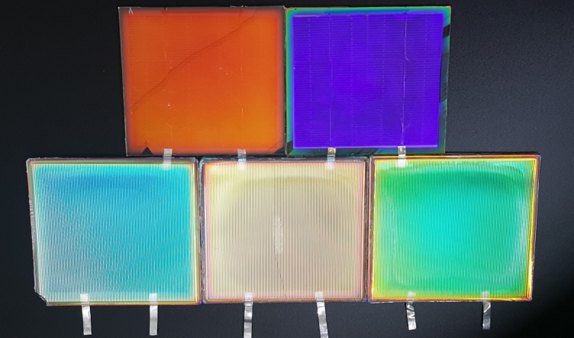Researchers at Delft University of Technology in the Netherlands have developed a computational model to apply colored optic filters to building-integrated BIPV products, in order to improve the visual impact of rooftop projects in urban environments.
“The filters are intended to be applied on already commercially available PV products,” researcher Juan Camilo Ortiz Lizcano told pv magazine. “They can be placed directly on a commercial solar cell to change its colour appearance or on the front glass of a PV module to hide the cells and create a coloured module.”
The research team said that the dark blue or black color of standard PV modules usually does not comply with the aesthetics of historic building restoration projects. This is a barrier to the adoption of solar in areas with cultural heritage value.
“Architects and project engineers have expressed that color and shape of modules are a limiting factor for BIPV implementation,” Ortiz Lizcano explained.
The optic filters were modeled on two dielectric layers – silicon dioxide (SiO2) and silicon nitride (SiNX). The scientists said they chose those layers because they can both be deposited via plasma-enhanced chemical vapor deposition (PECVD). The layers are able to improve color purity and brightness, while exhibiting low parasitic losses.
“On a potential upscale scenario, a single-sided, low-capex and high throughput physical vapor deposition technique, such as sputtering, could be suitable to manufacture these devices,” the researchers said.

Image: Simona Villa, Delft University of Technology
Ten pairs of the filters of different thickness combinations were modeled onto an interdigitated back-contacted (IBC) crystalline silicon solar cell with a power conversion efficiency of 21.36%. The academics evaluated the reflectance, absorptance, and transmittance spectra of the colored solar cell and applied a color perception model to predict the color produced by the filter.
“The main objective of this work is to find ways to accurately model the effect of implementing a color filter on a solar cell in a simplified way,” they said.
Through opto-electrical simulations, the Dutch group was able to ascertain that the filters do not affect the open-circuit voltage and fill factor of the cell, while the short-circuit current was negatively impacted. “Results showed that, for normal incidence of light, the green color reduces the efficiency of the cell by 0.78% absolute, whereas the brown presented a reduction of 1.40% absolute, mostly driven by current loss,” it emphasized, noting that the maximum efficiency loss recorded was 1.6%.
The researchers also discovered that the filters were also able to reduce the solar cell temperature, but this temperature drop was not found to bridge the gap in electrical performance between the cell with the filter and a reference cell without one.
“The techniques utilized to create the filters are readily available at an industrial scale, as well as the materials used to manufacture the filter,” Ortiz Lizcano said. “For these reasons, we believe that, from a technical perspective, the production of colored cells and modules with this approach should not represent a challenge.”
The researchers described the technique to fabricate the optic filters in “Colored optic filters on c-Si IBC solar cells for building integrated photovoltaic applications,” which was recently published in Progress in Photovoltaics..
This content is protected by copyright and may not be reused. If you want to cooperate with us and would like to reuse some of our content, please contact: editors@pv-magazine.com.




By submitting this form you agree to pv magazine using your data for the purposes of publishing your comment.
Your personal data will only be disclosed or otherwise transmitted to third parties for the purposes of spam filtering or if this is necessary for technical maintenance of the website. Any other transfer to third parties will not take place unless this is justified on the basis of applicable data protection regulations or if pv magazine is legally obliged to do so.
You may revoke this consent at any time with effect for the future, in which case your personal data will be deleted immediately. Otherwise, your data will be deleted if pv magazine has processed your request or the purpose of data storage is fulfilled.
Further information on data privacy can be found in our Data Protection Policy.